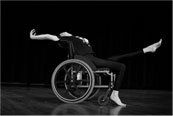Myth vs. Fact
Myths and Facts About People with Disabilities
Courtesy of the Easter Seals
Everybody's fighting some kind of stereotype, and people with disabilities are no exception. The difference is that barriers people with disabilities face begin with society's attitudes — attitudes often rooted in misinformation and misunderstandings about what it's like to live with a disability.

A woman who uses a wheelchair dances across the stage with her arms and legs outstretched.
Lisi Bansen, a member of That Uppity Theatre Company’s The DisAbility Project, refused to give up dancing, and instead found a way to express herself using her wheelchair.
Courtesy of That Uppity Theatre Company
Myth
People with disabilities are brave and courageous.
Fact
Adjusting to a disability requires adapting to a lifestyle, not bravery and courage.
Myth
All persons who use wheelchairs are chronically ill or sickly.
Fact
The association between wheelchair use and illness may have evolved through hospitals using wheelchairs to transport sick people. A person may use a wheelchair for a variety of reasons, none of which may have anything to do with lingering illness.
Myth
Wheelchair use is confining; people who use wheelchairs are "wheelchair-bound."
Fact
A wheelchair, like a bicycle or an automobile, is a personal assistive device that enables someone to get around.
Myth
All persons with hearing disabilities can read lips.
Fact
Lip-reading skills vary among people, so do not rely on a person being able to read your lips.
Myth
People who are blind acquire a "sixth sense."
Fact
Although most people who are blind develop their remaining senses more fully, they do not have a "sixth sense."
Myth
Non-disabled people are obligated to "take care of" people with disabilities.
Fact
Anyone may offer assistance, but most people with disabilities prefer to be responsible for themselves.
Myth
Curious children should never ask people about their disabilities.
Fact
Many children have a natural, uninhibited curiosity and may ask questions that some adults consider embarrassing. But scolding curious children may make them think having a disability is "wrong" or "bad." Most people with disabilities won't mind answering a child's question.
Myth
The lives of people with disabilities are totally different from the lives of people without disabilities.
Fact
People with disabilities go to school, get married, work, have families, do laundry, grocery shop, laugh, cry, pay taxes, get angry, have prejudices, vote, plan, and dream like everyone else.
Myth
It is all right for people without disabilities to park in accessible parking spaces, if it’s only for a few minutes.
Fact
Because accessible parking spaces are designed and situated to meet the needs of people who have disabilities, these spaces should be used only by people who need them.
Myth
Most people with disabilities cannot have sexual relationships.
Fact
Anyone can have a sexual relationship by adapting the sexual activity. People with disabilities can have children naturally or through adoption. People with disabilities, like other people, are sexual beings.
Myth
People with disabilities always need help.
Fact
Many people with disabilities are independent and capable of giving help. If you would like to help someone with a disability, ask if he or she needs it before you act.
Myth
There is nothing one person can do to help eliminate the barriers confronting people with disabilities.
Fact
Everyone can contribute to change. You can help remove barriers by:
- Understanding the need for accessible parking and leaving it for those who need it
- Encouraging participation of people with disabilities in community activities by using accessible meeting and event sites
- Understanding children's curiosity about disabilities and the people who have them
- Advocating a barrier-free environment
- Speaking up when negative words or phrases are used about disability
- Writing producers and editors a note of support when they portray someone with a disability as a "regular person" in the media
- Accepting people with disabilities as individuals with the same needs and feelings as yourself, and hiring qualified disabled persons whenever possible.
Missouri History Museum exhibition
Americans with Disabilities Act: 20 Years Later.
June 26, 2010
to Jan 8, 2012
